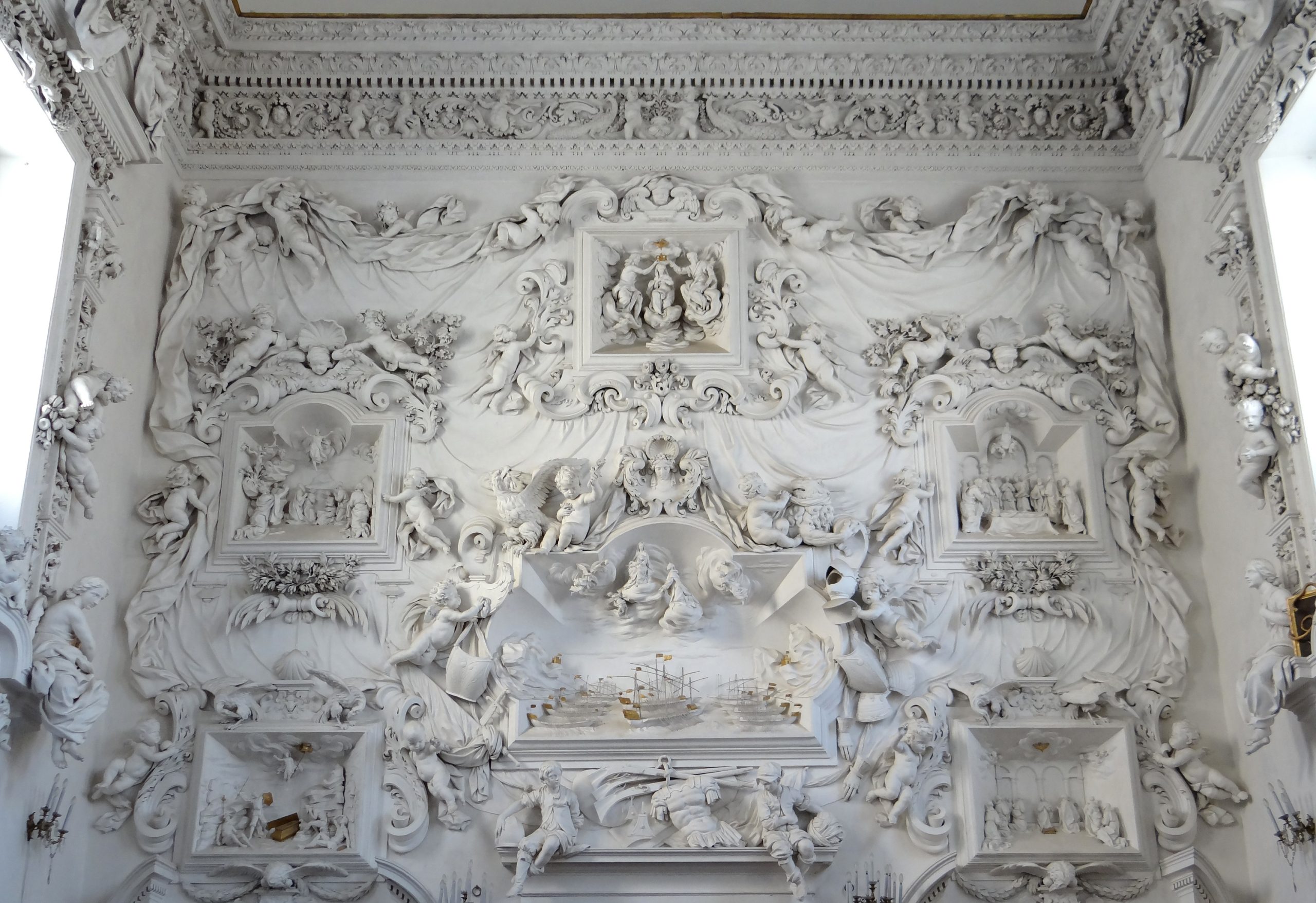
Read English version
Una tappa obbligatoria per chi ama lo stile barocco e vuole scoprire un autentico gioiello della nostra città è l’Oratorio del Rosario in Santa Cita, famoso per gli stucchi di Giacomo Serpotta, colui che Donald Garstang definì “il principale artista dello stucco in Europa” e Giulio Carlo Argan considerò “uno dei massimi scultori del Settecento”.
Per quanto sobrio e severo vi possa apparire il portone d’ingresso, non esitate, entrate pure. All’interno, volutamente protetto dagli occhi indiscreti dei comuni mortali non appartenenti alla Compagnia, si nasconde un gioiello di grande prestigio artistico.
L’oratorio deve il suo nome alla vicina chiesa del monastero dei Domenicani di Santa Cita, una santa lucchese vissuta tra il 1218 e il 1278.
Saliti alcuni gradini e superato il portone d’ingresso, si attraversa un loggiato tardo cinquecentesco a doppio ordine. L’aula rettangolare, che ospita l’oratorio, è interamente ricoperta di magnifici stucchi del Serpotta eseguiti a varie riprese dal 1685 al 1718: statue allegoriche, tripudio di putti, piccole rappresentazioni dei Misteri del Rosario.
Per i suoi stucchi Giacomo Serpotta crea una fastosa decorazione, nello specifico nobilitò la tecnica dello stucco, tradizionalmente povera, aggiungendo polvere di marmo alla calce e al gesso, donando così lucentezza e pregio alle sue opere.
La struttura architettonica dell’oratorio è molto semplice: la sala rettangolare ha un unico altare e presenta finestre lungo le pareti che accolgono i banchi dei confrati, splendido capolavoro di artigianato ligneo, intarsiati di madreperla. Notevole anche il pavimento di marmo ad intarsio.
E’ proprio nell’aula dell’oratorio che il Serpotta esprime al massimo la sua creatività iconografica ed espressiva. Sublime la parete d’ingresso: in un drappo modellato in stucco, e srotolato da leziosi putti, si adagiano quattro rilievi circondati anche da fiori e palme. Al centro è la rappresentazione della Battaglia di Lepanto sormontata dal rilievo con l’Incoronazione di Maria. Al di sotto della battaglia di Lepanto Serpotta modellò due giovinetti con gli emblemi delle due parti in lotta: l’elmo di un crociato e il turbante di un musulmano.
Sull’altare la Madonna del Rosario tra Santi domenicani di Carlo Maratta (1695)
Fonte: Le Chiese a Palermo di Ettore Sessa . Editore Ugo La Rosa
Palermo Storia e Arte . Edizioni Leopardi
The Oratory of the Rosary in Santa Cita is a must for those who appreciate the Baroque style and want to see an authentic jewel of the city.
It is famous for the stucco decorations by Serpotta, the one that Donald Garstang called the main artist of stucco in Europe and Giulio Argan considered one of the greatest sculptors of the eighteenth century.
Although the front door may appear severe, referring to its style, do not hesitate, go into. Inside, deliberately protected from the prying eyes of mere mortals not belonging to the Company, there is a jewel of great artistic prestige.
The Oratory owes its name to the nearby church of the Dominican monastery of Santa Cita, a saint from Lucca who lived between 1218 and 1278.
Up some steps and past the front door, you cross a late sixteenth century double-order loggia. The rectangular hall, which houses the Oratory, is entirely covered with magnificent stuccoes by Serpotta executed on various occasions from 1685 to 1718: allegorical statues, a triumph of putti, small representations of the Mysteries of the Rosary.
Giacomo Serpotta created a sumptuous decoration for his stuccoes. He ennobled the traditionally poor stucco technique by adding marble powder to the lime and plaster, thus giving his works lustre and value.
The architectural structure of the Oratory is very simple: the rectangular room has a single altar and has windows along the walls that welcome the benches for the confreres -brothers- inlaid with mother of pearl; they are a splendid masterpiece of wooden craftsmanship. The inlaid marble floor is also noteworthy.
It is precisely in the hall of the Oratory that Serpotta expresses his iconographic and expressive creativity to the maximum. The entrance wall is sublime: in a drape modelled in stucco, and unrolled by graceful putti, four reliefs lie also surrounded by flowers and palms. In the center is the representation of the Battle of Lepanto surmounted by the relief with the Coronation of Mary. Below the battle of Lepanto, Serpotta modelled two young men with the emblems of the two fighting sides: the helmet of a crusader and the turban of a Muslim.
At the altar there is the Madonna del Rosario among Dominican Saints by Carlo Maratta (1695)
Visits: Every day from 10.00am to 6.00pm.
Visits are suspended during religious ceremonies and wedding celebrations.
Ticket.
info: Confraternity of San Mamiliano tel 091 33 27 79 – 091 7853181
N.B.: With the Oratory ticket you can take advantage of the discounted ticket in the Sacred Art Circuit
For more information: i tesori della Loggia
